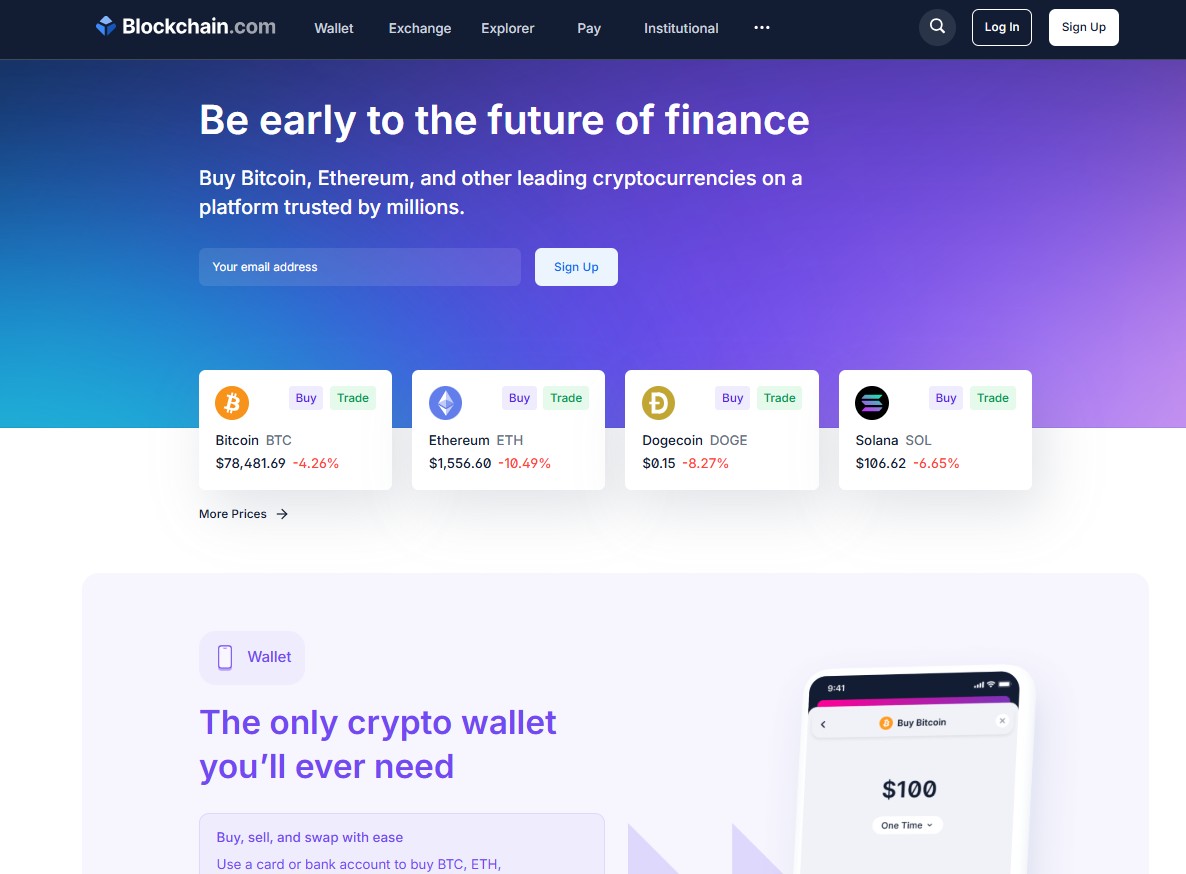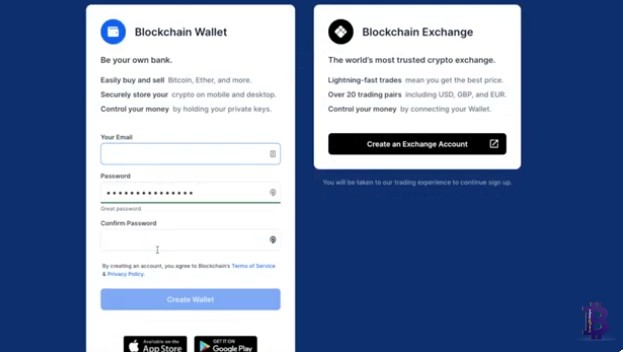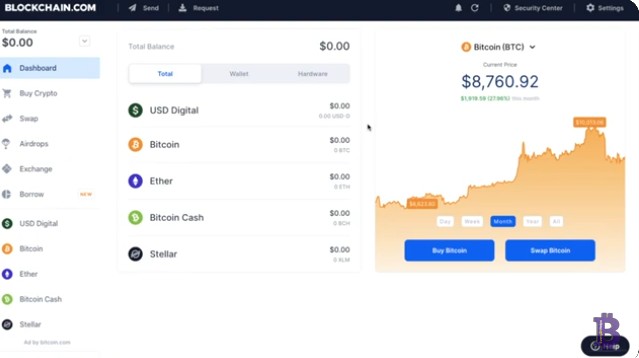Blockchain.com Wallet Review 2025



Editorial Note: While we adhere to strict Editorial Integrity, this post may contain references to products from our partners. Here's an explanation for How We Make Money. None of the data and information on this webpage constitutes investment advice according to our Disclaimer.
The Blockchain.com wallet is a secure, user-friendly crypto wallet offering both custodial and non-custodial options. It allows users to store, trade, and earn crypto in one place, making it ideal for both beginners and experienced investors.
In this review, we’ll break down everything you need to know about the Blockchain.com wallet in 2025 — from features and supported coins to fees, mobile experience, security, and how it compares to popular alternatives. Whether you're new to crypto or switching from another wallet, this guide will help you decide if Blockchain.com is the right fit.
Risk warning: Cryptocurrency markets are highly volatile, with sharp price swings and regulatory uncertainties. Research indicates that 75-90% of traders face losses. Only invest discretionary funds and consult an experienced financial advisor.
Blockchain.com wallet overview
The Blockchain.com wallet is a hybrid wallet that offers both custodial and non-custodial options. This means users can choose to hold their private keys (self-custody) or let Blockchain.com manage them (custodial). It’s designed for flexibility, convenience, and easy access to crypto features like trading, DeFi, and earning interest.

As one of the earliest wallets in the crypto space — launched in 2011 — Blockchain.com has a long-standing reputation for reliability. Over the years, it has expanded its functionality to keep up with user demand, making it more than just a storage wallet. You can now swap crypto, track prices, and even access DeFi tools directly from the app.
| Feature | Details |
|---|---|
| Wallet type | Hybrid (custodial + non-custodial), available via web and mobile |
| Cloud backup | Yes – for easy recovery |
| Supported coins | BTC, ETH, USDT, BCH, XLM, AVAX, ERC-20 tokens, and more |
| App availability | iOS and Android |
| Security features | 2FA, biometric login, AES encryption, cloud backup |
| Best for | Users who want flexibility and ease of use |
| Fees | Free wallet, fees apply for trading, swaps, and network transactions |
Key features of Blockchain.com wallet
Hybrid custodial and non-custodial access
Blockchain.com gives users the option to control their crypto in two ways. You can hold your private keys yourself (non-custodial), or let Blockchain.com manage them (custodial). This hybrid setup is perfect for those who want flexibility between convenience and control.
With self-custody, you have full control over your funds. But if you prefer a simpler setup, the custodial option means Blockchain.com handles key storage and backup. The wallet makes it easy to switch between the two.
Built-in crypto trading
You can buy, sell, and swap crypto without leaving the Blockchain.com wallet. It integrates a trading platform directly into the app, allowing for instant exchanges between coins. This eliminates the need for separate accounts or platforms.
Earn interest on crypto holdings
Blockchain.com offers interest-earning features on certain coins like Bitcoin and stablecoins. This gives you the chance to grow your holdings passively, similar to a savings account — but for crypto.
Pros and cons of Blockchain.com wallet
- Pros
- Cons
Hybrid custodial model. Users can choose between non-custodial access (holding their own private keys) and custodial access (letting Blockchain.com manage keys). This offers flexibility between control and convenience.
Built-in trading and earning tools. The wallet includes features for buying, selling, swapping crypto, and earning interest — allowing users to manage assets without switching platforms.
User-friendly interface. Available on both mobile and web, the wallet offers a simple and clean layout suitable for beginners and experienced users alike.
Established reputation. Blockchain.com has been active since 2011 and is one of the most recognized names in the crypto wallet space.
Strong security measures. Includes two-factor authentication (2FA), biometric login, and AES-256 encryption to enhance security and protect user data.
Not open-source. The codebase is not publicly available, which may concern users who value transparency and independent verification.
Limited coin support. Compared to some other wallets, especially DeFi-focused ones, Blockchain.com supports a smaller selection of cryptocurrencies.
Restricted features by region. Certain services like trading or earning interest are not available in all countries, which could limit functionality for some users.
Customer support delays. Some users have reported slow response times when contacting support, which may affect the overall experience.
Transaction and trading fees. While wallet access is free, fees for trades, swaps, and blockchain network transactions may be higher than some alternatives.
Blockchain.com wallet security review
Security is crucial for every wallet. Below is a detailed review of Blockchain.com wallet:
Self-custody & custodial options
Blockchain.com provides users with the choice between self-custody and custodial wallets. The self-custody option allows users to retain full control over their private keys, aligning with the principle of "not your keys, not your crypto." Conversely, the custodial option manages private keys on behalf of the user, offering a more streamlined experience. This dual approach caters to varying preferences regarding control and convenience.
2FA and biometric login
To enhance security, the wallet supports Two-Factor Authentication (2FA), adding an extra layer of protection during login and transaction processes. Additionally, mobile users can enable biometric authentication, such as fingerprint or facial recognition, providing a balance between security and user convenience.
Cloud backup for recovery
Recognizing the importance of recovery options, especially for self-custody wallets, Blockchain.com offers encrypted cloud backup. This feature allows users to securely store their recovery phrases, facilitating easier restoration of access in case of device loss or failure. It addresses a common challenge associated with self-custody solutions by providing a safety net for users who might misplace their recovery information.
Non-open source code
Unlike some other wallets in the cryptocurrency space, Blockchain.com's wallet is not open-source. This means that its codebase isn't publicly accessible for review, which might be a consideration for users who prioritize transparency and the ability to audit software independently. However, the company emphasizes its commitment to security through regular third-party audits and adherence to industry best practices.
Supported coins & tokens
Blockchain.com wallet supports a wide range of popular and emerging cryptocurrencies. This includes major coins such as Bitcoin (BTC), Ethereum (ETH), Tether (USDT), Bitcoin Cash (BCH), Stellar (XLM), and Avalanche (AVAX). It also supports various ERC-20 tokens and DeFi assets, giving users access to a broad crypto portfolio.
The wallet allows users to trade supported coins directly within the app using trading pairs like BTC/ETH, ETH/USDT, and more. This makes it easier to manage and exchange crypto without switching platforms. While it may not include every altcoin on the market, it covers most of the essential assets used for trading, holding, or earning.
How to use Blockchain.com wallet: A step-by-step guide
Check out the steps below on how to use the Blockchain.com wallet:
Step 1: Download and install the app
Head to the Google Play Store or Apple App Store and search for “Blockchain wallet.” Download and install the official app developed by Blockchain Luxembourg S.A.
Once installed, open the app and choose whether to create a new wallet or restore an existing one.

Step 2: Set up your wallet
When creating a new wallet, you’ll be asked to create a strong password and set up backup options. If you choose self-custody, you’ll be given a recovery phrase to write down and store securely.
You can also enable biometric login and cloud backup for convenience and added security.

Step 3: Add crypto or make a purchase
You can receive crypto by sharing your wallet address or QR code. You can also buy crypto directly in the app using your bank card or other payment methods supported in your region.
Once your wallet is funded, you can start sending, trading, or earning interest on your crypto.

Alternatives to Blockchain.com wallet
Looking for something other than Blockchain.com wallet? Here are some of its alternatives:
Trust wallet
Trust wallet is a non-custodial mobile wallet owned by Binance. It supports a wide range of coins and DeFi apps. It’s great for users who want full control and broad token access. However, it doesn’t offer built-in earning or trading tools, so you’ll need to connect it to other platforms.
Coinbase wallet
Coinbase wallet is separate from the Coinbase exchange, offering full self-custody. It’s ideal for those who want DeFi access and NFT support. Like Blockchain.com, it’s beginner-friendly but focused more on Web3 features than hybrid custodial options.
MetaMask
MetaMask is a favorite among Ethereum and DeFi users. It supports multiple chains, dApps, and tokens, but it has a steeper learning curve. Blockchain.com is easier for beginners, while MetaMask is more suitable for advanced users who want DeFi access.
Storing crypto on exchanges: An alternative to wallet apps
Some users prefer to store their crypto assets directly on centralized trading platforms. This method offers convenience and quick access to trading features, making it a popular choice among active traders. However, it also comes with certain risks.
When funds are held on an exchange, the platform retains control of the private keys. As a result, users do not have complete ownership of their assets. Despite advanced security measures, these platforms remain potential targets for cyberattacks and outages, which can compromise access and safety.
For those who prioritize control and long-term security, using a dedicated wallet like Blockchain.com is a more suitable option. It enables users to hold their own private keys, reducing reliance on third parties. Self-custody wallets also offer greater flexibility for interacting with DeFi applications and managing assets independently over the long term.
To help you compare your options, we’ve put together a carefully selected list of trusted crypto exchanges based on security, usability, and overall reliability.
| Foundation year | Min. Deposit, $ | Spot Taker fee, % | Spot Maker Fee, % | Deposit fee | Withdrawal fee | Demo account | Regulation | TU overall score | Open an account | |
|---|---|---|---|---|---|---|---|---|---|---|
| 2017 | 10 | 0,1 | 0,08 | No | 0,0004 BTC 2,6 USDT | Yes | No | 8.9 | Open an account Your capital is at risk. |
|
| 2011 | 10 | 0,4 | 0,25 | No | 0,0005 BTC | No | No | 8.48 | Open an account Your capital is at risk. |
|
| 2016 | 1 | 0,5 | 0,25 | No | 0,0005 BTC | No | Malta Financial Services Authority | 8.36 | Open an account Your capital is at risk. |
|
| 2018 | 1 | 0,2 | 0,1 | No | 0-0,1% | Yes | No | 7.41 | Open an account Your capital is at risk. |
|
| 2004 | No | 0 | 0 | No | No | No | No | 7.3 | Open an account Your capital is at risk. |
Why trust us
We at Traders Union have over 14 years of experience in financial markets, evaluating cryptocurrency exchanges based on 140+ measurable criteria. Our team of 50 experts regularly updates a Watch List of 200+ exchanges, providing traders with verified, data-driven insights. We evaluate exchanges on security, reliability, commissions, and trading conditions, empowering users to make informed decisions. Before choosing a platform, we encourage users to verify its legitimacy through official licenses, review user feedback, and ensure robust security features (e.g., HTTPS, 2FA). Always perform independent research and consult official regulatory sources before making any financial decisions.
Learn more about our methodology and editorial policies.
Dual wallet strategy and transaction buffering
If you’re a beginner using Blockchain.com wallet, one powerful move that few talk about is strategically using both the custodial and non-custodial wallets in parallel to diversify risk and functionality. For instance, you can use the custodial wallet to actively swap tokens and earn interest — since it’s easier to manage and recover — while simultaneously using the non-custodial wallet to store a portion of your long-term holdings that you don’t touch often.
Another overlooked trick is to use your non-custodial Blockchain.com wallet as a transaction buffer between exchanges and cold storage. Say you bought crypto on an exchange. Instead of sending it directly to a cold wallet, first move it to your Blockchain.com non-custodial wallet.
This extra step helps you monitor and verify funds, apply any additional 2FA checks, and sanitize the on-chain history before locking it away. It’s especially useful if you’re concerned about tainted coins or want cleaner transaction trails for the future — say for legal, tax, or compliance purposes.
Conclusion
Blockchain.com wallet continues to stand out in 2025 as a practical choice for anyone looking to manage crypto securely and easily. Its hybrid design lets users choose between custodial simplicity and self-custody control — something not many wallets offer. You can buy, sell, earn, and store crypto all in one place, with built-in safety features like 2FA and encryption. Whether you're a beginner looking for an all-in-one wallet or someone moving away from exchanges to take control of your keys, Blockchain.com is a solid option to consider for your daily crypto management needs.
FAQs
Can I use Blockchain.com wallet without verifying my identity?
Yes, you can use the self-custodial version without full identity verification. However, KYC is required for using certain features like buying or selling crypto within the app.
Does Blockchain.com wallet support hardware wallet integration?
No, as of now, Blockchain.com wallet doesn’t offer direct support for hardware wallets. It's designed primarily for mobile and web-based access.
Is Blockchain.com wallet suitable for storing NFTs?
Currently, Blockchain.com wallet doesn’t support NFT storage or management. If NFTs are part of your portfolio, you might need a separate wallet for that.
Can I use Blockchain.com wallet offline?
No, it is an internet-connected hot wallet. Offline functionality, like cold storage, isn’t available within the app.
Related Articles
Team that worked on the article
Alamin Morshed is a contributor at Traders Union. He specializes in writing articles for businesses that want to improve their Google search rankings to compete with their competition. With expertise in search engine optimization (SEO) and content marketing, he ensures his work is both informative and impactful.
Chinmay Soni is a financial analyst with more than 5 years of experience in working with stocks, Forex, derivatives, and other assets. As a founder of a boutique research firm and an active researcher, he covers various industries and fields, providing insights backed by statistical data. He is also an educator in the field of finance and technology.
As an author for Traders Union, he contributes his deep analytical insights on various topics, taking into account various aspects.
Mirjan Hipolito is a journalist and news editor at Traders Union. She is an expert crypto writer with five years of experience in the financial markets. Her specialties are daily market news, price predictions, and Initial Coin Offerings (ICO).
Yield refers to the earnings or income derived from an investment. It mirrors the returns generated by owning assets such as stocks, bonds, or other financial instruments.
An investor is an individual, who invests money in an asset with the expectation that its value would appreciate in the future. The asset can be anything, including a bond, debenture, mutual fund, equity, gold, silver, exchange-traded funds (ETFs), and real-estate property.
Ethereum is a decentralized blockchain platform and cryptocurrency that was proposed by Vitalik Buterin in late 2013 and development began in early 2014. It was designed as a versatile platform for creating decentralized applications (DApps) and smart contracts.
Bitcoin is a decentralized digital cryptocurrency that was created in 2009 by an anonymous individual or group using the pseudonym Satoshi Nakamoto. It operates on a technology called blockchain, which is a distributed ledger that records all transactions across a network of computers.
Crypto trading involves the buying and selling of cryptocurrencies, such as Bitcoin, Ethereum, or other digital assets, with the aim of making a profit from price fluctuations.































































































































